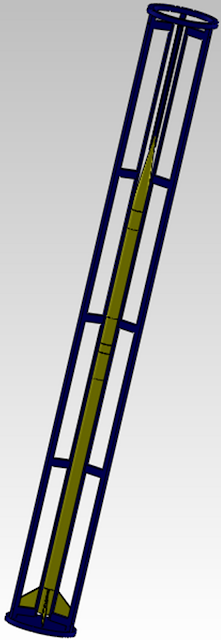Our final project for the semester is to assemble our design into a very large poster (it's like four feet wide). I'd like to share it with you! But instead of just posting a little picture of it, I've re-written it in post form so you can actually read it. That said, here it is:
ISU
Rockoon
Goals/Objectives
The objective of the Rockoon Project is
to build a fully reusable, economic, lightweight and stable sounding rocket to
be assisted by a high-altitude balloon. The rocket will be launched near the
stratosphere, to an altitude of at least 140,000 ft.
The Rockoon
will be powered by a L-class impulse rocket engine to carry video and
communication systems (allowing the entire rocket flight to be live
video-streamed), GPS tracking system, navigation-sensor systems, telemetry
system and any payloads of interest to be used for
experimental flights. Recovery
systems will be used for
safe return of
the rocket and platform to the ground, making the Rockoon system
reusable.
History
The concept of a Rockoon was
first developed in 1949 by the Aerobee Rocket engineering crew and consisted of
a sounding rocket that was
launched from a balloon, rather than from the
ground to achieve higher altitudes. James Van Allen was the first to use the
rocket-balloon combination to study the atmosphere in 1952. In 1953 Rockoons
fired off Newfoundland detected
the first hint of radiation belts
surrounding Earth. The low-cost Rockoon technique was later used by the Office
of Naval Research and The University of Iowa research groups in 1953-55 and
1957, from ships in sea between Boston and Thule, Greenland.

Launch
Platform Design
The launch
platform is essentially the fundamental component of a Rockoon system, as it is
the part the actually connects high powered rocketry with high altitude
ballooning. The platform needs to be durable and lightweight, but able to house
the rocket and electronics, and be able to successfully launch the rocket.
The platform will be a “cannon” like design connected to a multiple
balloon system, with the rocket sitting in the middle of the platform
surrounded by three side rails. These side rails will hold the rocket in
place while it’s being towed to launch altitude, along with keeping the rocket
stable while it reaches a sufficient launch velocity. The platform will
also house electronics that will allow us to track the platform and actually
communicate with the rocket prior to motor ignition.
Electronics
The electronic systems for the launch
platform have to perform four basic functions: (1) Monitor the motion of the launch platform, (2)
Receive command to launch the rocket,
(3) Track the launch platform via GPS, and (4) after ignition of the rocket,
cut-down from the balloons so that the platform would return to Earth. The
first flight of the launch platform will be to test the reliability of the
launch platform and electronics without the launch of a rocket. Several cameras
will monitor the motion of the balloons and the platform. An onboard
accelerometer and gyro sensor will record motion data to an onboard micro-SD
card. These functions, along with the ignition and balloon cut-down will be
controlled by an Arduino MCU, and are depicted schematically in the figure
below.
Rocket
Design
The rocket design is based off of a
carbon fiber airframe that was passed down to us from our predecessors. It will
be a minimum diameter rocket that is just over eight feet tall made completely
of carbon fiber. The nose cone has a metal tip to help burst through balloons
if needed. This rocket will be flown on
a Cesaroni
4-grain, level-two L motor. Payloads
will consist of a GPS, CO2 pressure ejection system for
recovery, an accelerometer, and a camera
with the possibility of a live video stream.
Initial RockSim simulations predict a maximum altitude
of 157,000 feet, and a maximum velocity of 2427 feet per second (Mach
2.4).
The design for this rocket has a center
of gravity of 76.7 inches and a center of pressure of 91.8 inches, giving a
static margin of 4.8 caliber. If the launch were to occur from the ground this
margin would be too high, but since the launch will occur at higher altitudes,
the perturbing effects will be much less effective due to the lower air
density. Due to launching at high altitudes, bigger than normal fins will be
used and an exit velocity of about 150 feet per second from the platform will
be needed for stable flight.
Flight Performance Analysis (RockSim)









